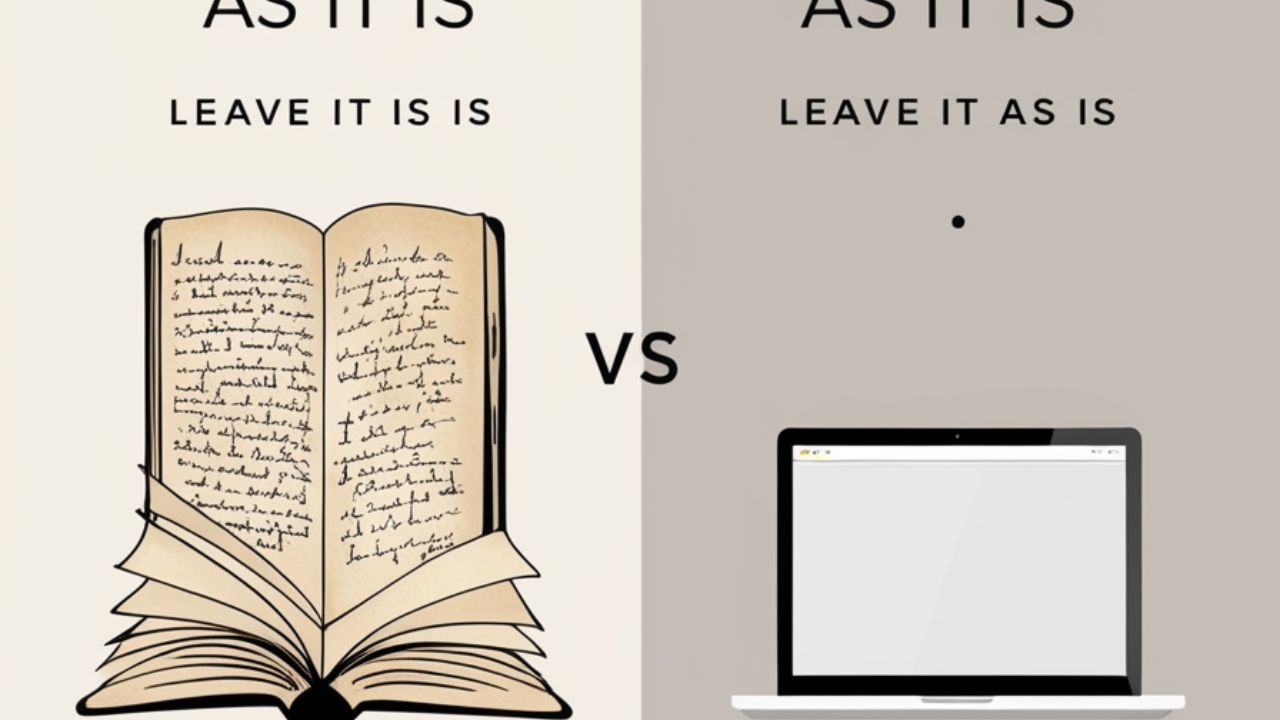Leave it as it is means keeping something the same and not changing it. People use it when they feel something looks fine the way it is. This phrase sounds calm and careful, showing that the thing already feels complete or just right.
Leave it as is sounds shorter and more direct. People often use it at work or when they need to finish something quickly. It shows confidence and simplicity, meaning there’s no need to add, fix, or touch anything more.
Both phrases tell someone not to make changes, but each gives a slightly different feeling. The first feels softer and more emotional, while the second feels clear and strong. Choosing the right one depends on how formal or simple you want to sound.
Core Meaning of Both Phrases: Grammar and Syntax Breakdown
The phrase leave it as it is uses a full idea that shows something should stay the same. It has a clear subject and verb, making it sound complete. This form often feels gentle and careful, especially when someone values what already exists.
The phrase leave it as is sounds shorter and quicker. It removes extra words but keeps the same meaning. This version feels modern and easy to use in simple talk or writing. It helps people speak clearly without sounding too formal.
See also Born With a Silver Spoon Meaning & Modern Impact
| Phrase Variant | Full Breakdown |
| leave it as it is | Leave (verb) + it (object) + as it is (complete clause) |
| leave it as is | Leave (verb) + it (object) + as is (reduced clause) |
- Leave it as it is uses a full sentence idea with a subject and verb, showing completeness and care. It sounds formal and gentle, often used when someone values keeping something unchanged.
- Leave it as is removes the extra word “it,” making the phrase shorter and quicker. It means the same thing but feels simpler and more modern in tone.
- Both forms are grammatically correct, but the choice depends on style and situation—one feels emotional and full, while the other feels practical and direct.
What Does “Leave It As It Is” Actually Mean?
The phrase leave it as it is means keeping something exactly the way it already looks or feels. It shows care and respect for the current state. People use it when they think nothing needs fixing or changing at all.
Writers and speakers often choose leave it as it is when they want to sound gentle and thoughtful. It gives a feeling of calm and balance, showing that the person believes things are fine and should stay just like that.
Examples:
- “The old photo looks perfect, so leave it as it is.”
- “The report design works fine—just leave it as is.”
- “We’ll keep the wall color the same and leave it as it is for now.”
When Is “Leave It As Is” the Better Choice?

The phrase leave it as is works best when someone wants clear and quick communication. It sounds simple and firm, which makes it good for offices, schools, or teamwork. People use it when something already looks fine or fits the need perfectly.
Many professionals prefer leave it as is in reports or short notes because it saves time. It helps express confidence and decision without adding emotion. This version feels tidy, polite, and easy to understand in most daily conversations.
Examples:
- “The picture frame fits well; leave it as is.”
- “I like the story’s ending, so leave it as it is.”
- “The website layout looks fine; leave it as is until the update.”
Ellipsis in Language: Why ‘It’ Can Be Dropped Without Changing the Meaning
The idea of ellipsis means leaving out a word that people already understand from the rest of the sentence. In the phrase leave it as is, the word “it” is missing, but everyone knows what it refers to. This makes the sentence short and neat.
Writers use ellipsis to make language sound smoother and simpler. It helps avoid saying the same word again and again. The meaning stays clear because the listener already understands what’s being talked about from earlier in the sentence.
- Ellipsis means leaving out words that are already understood. In leave it as is, the second “it” is not needed because the meaning stays clear.
- This helps make sentences shorter and smoother while keeping the same idea.
- Writers use ellipsis to sound natural and avoid repeating words, which makes the language simple and easy to read.
Tone, Emphasis, and Intent: What the Choice Communicates
| Phrase | Emotional Impact | Use Case |
| Leave it as it is | Reflective, protective, emotional | When expressing care, nostalgia, or resistance to change |
| Leave it as is | Objective, direct, practical | When giving instructions, critique, or feedback |
Common Errors and Misconceptions
| Mistake | Correction |
| “Leave as is” (missing ‘it’) | “Leave it as is” |
| “Leave as it is” (missing ‘it’) | “Leave it as it is” |
| Assuming “as is” is slang | It’s valid English grammar |
| Mixing both forms in the same sentence | Stick with one for clarity |
- Some people think leave it as is is wrong or too casual, but it’s completely correct and often used in professional writing.
- Many forget to include “it” and write “leave as is,” which sounds incomplete and unclear.
- Mixing leave it as it is and leave it as is in one sentence can confuse readers, so it’s best to use only one form at a time.
See also Fingers Crossed Meaning & Use: Hope, Luck, or Deception
Real-World Usage in Different Contexts
Workplace Communication
- In offices, people use leave it as is to give quick and clear directions during meetings or reviews.
- It helps teams save time by showing that something doesn’t need editing or changes.
- Leave it as it is sounds softer and is used when someone wants to respect another person’s work or choice.
Home and Everyday Conversation
- At home, people say leave it as it is when they want to keep something special, like an old picture or a family recipe.
- Leave it as is is used for simple tasks, like keeping a room the same for now.
- Both phrases help express comfort, care, or ease in daily talk without sounding too formal.
How Style Guides and Editors Treat the Two Forms
| Style Guide | Preference | Reason |
| Chicago Manual of Style | “Leave it as it is” | Clarity in narrative writing |
| AP Stylebook | “Leave it as is” | Concise, journalistic expression |
| Oxford Style Guide | Either | Depends on tone and medium |
Expert Opinions and Linguistic Data

Many language experts say leave it as it is sounds older and more emotional, while leave it as is feels modern and short. Studies in language use show that people now prefer shorter forms, especially in business or online writing.
Linguists explain that both choices are grammatically right but express different tones. Old books and stories use leave it as it is more often, while modern talks and reports use the shorter style. Both show how language keeps changing over time.
Quick Reference: Table of Differences
| Phrase | Tone | Formality | Use Case | Preferred By |
| Leave it as it is | Thoughtful | High | Literature, personal writing | Writers, academics |
| Leave it as is | Practical | Medium | Business, instructions, feedback | Designers, editors |
Final Thoughts
Understanding the phrase leave it as it is helps people speak and write more clearly. It teaches how small word choices can change tone and feeling. Learning this makes language use stronger and shows respect for how words express meaning.
Writers and speakers can use leave it as is when they want a simple and quick message. Knowing both forms builds better communication skills. It helps people choose the right words for every moment with care and confidence.
What is the difference between “leave it as it is” and “leave it as is”?
The phrase leave it as it is shows more feeling and care. It often appears when someone wants to keep something special or unchanged. It sounds soft and thoughtful, making it good for writing that talks about memories or emotions.
The shorter form leave it as is feels more direct and useful. It’s often used at work or in simple talk when people want quick understanding. Both phrases mean not to change something, but their tones are slightly different.
FAQs
What does leave as it is mean?
It means not making any changes or keeping something in its current state.
What is correct, as is or as it is?
Both are correct; “as is” is shorter and often used formally, while “as it is” sounds more natural in conversation.
What does “leave it as it is” mean?
It means to keep something unchanged, exactly the way it currently exists.
What is another word for “leave as it is”?
You can say “keep unchanged,” “leave untouched,” or “maintain the same.”

Join Bibcia on a journey to master English grammar. Discover easy lessons, writing tips, and practical examples designed to make learning grammar simple and effective.










